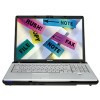- Qualcomm Launches Snapdragon 4 Gen 2 Mobile Platform
- AMD Launches Ryzen PRO 7000 Series Mobile & Desktop Platform
- Intel Launches Sleek Single-Slot Arc Pro A60 Workstation Graphics Card
- NVIDIA Announces Latest Ada Lovelace Additions: GeForce RTX 4060 Ti & RTX 4060
- Maxon Redshift With AMD Radeon GPU Rendering Support Now Available
Toshiba Satellite P205D-S7479

Toshiba’s latest AMD notebook offering proves that even those on a relative budget deserve a feature-packed model. Besides its 17-inch display, the P205D-S7479 offers nice harman/kardon speakers, a thumbprint reader, a large 250GB hard-drive, an ATI HD 2600 – all for a light price.
Page 3 – Performance
|
|
Being a notebook designed for value-conscious shoppers, we are not going to expect extreme performance here. Clock for clock, an Intel CPU would likely prove a better choice for overall application performance, although the AMD Turion is still fully capable of handling your tasks with relative ease.
There are a few components that will assure less-than-perfect application speeds, including the hard-drive and the video card. Although the 250GB drive is sweet to have, its 4200RPM speeds will make a few processes slow, such as game level loading, saving a large file, or even copying a folder from one part of the drive to another.
The video card, might be another huge bottleneck, but that’s to be expected for a notebook of this price-range. The HD 2600 will prove no limitation for video or other simple 3D applications, but games will need to be run in lower resolutions in order to be playable. On top of this, brand-new games (such as Crysis, Bioshock) are not going to be enjoyable on this particular notebook.
For testing, I used a variety of real-world benchmarks in addition to PCMark Vantage and Sandra, two synthetic benchmarking tools. Our battery tests are completed with the help of Bapco’s SYSmark 2007 Preview. If you are new to our reviews and are unsure how we complete our real-world tests, please refer to our recent Intel QX9770 review, where all tests are explained in detail.
|
Benchmark
|
Results
|
| Battery Life Productivity DVD Movie Watching |
1h 30m 1h 25m |
| 7-Zip Archiving Compress 4GB Folder |
25:09 |
| Adobe Lightroom Export 100 RAW to resized JPEG |
8:00 |
| Autodesk 3DS Max 9 Render 1920×1080 Single Frame Render 490×270 60-Frames |
2:05 8:35 |
| HD Tach RW/3 Burst Speed MB/s Average Read MB/s Latency |
49.6MB/s 31.1MB/s 19.9ms |
| Nero Recode Recode 9GB DVD to 4.5GB Recode 9GB DVD to 1GB for iPod |
16:03 25:46 |
| Sandra Memory Int MB/s FLOAT MB/s |
6515MB/s 6506MB/s |
| PCMark Vantage PCMark Suite Memories TV and Movies Gaming Music Communications Productivity HDD Test |
2505 1716 1762 2260 2533 2286 2322 1883 |
The absolute biggest problem with our results, to me, is battery life. While not a notebook that promises long-life, for a “media-notebook” you’d imagine that you could at least finish a single DVD movie before needing to shut down, but that’s not the case at all. To make sure that the battery life was accurate, I manually tested using one of my concert DVDs, and sure enough, I hit 1h 20m. SYSmark hit 1h 30m, so I averaged the result.
Performance aside from that is acceptable, but nothing mind-blowing. It’s going to be one of those notebooks that offers sufficient performance, but is for those who have a fair amount of patience and don’t mind waiting a few extra minutes for an intensive process to finish.
When you consider that our E6600 machine hit a 4:31 time in our Adobe Lightroom test, the notebook didn’t perform too poorly. The E6600 has obvious benefits, including that it’s based on the efficient Core micro-architecture, and also had a higher clock speed and a much, much faster hard-drive.
I did a fair amount of gaming on this notebook, but didn’t record the frame-rates, because often the Avg FPS will appear far better than the actual game play represents, so I am just going to relay my experiences instead.
Brand-new FPS games are not going to play that well on this laptop, and if you lower the graphic settings enough to the point that they are playable, it will not be that enjoyable thanks to poor graphics. Half-Life 2: Episode Two offered perfect performance at 1440×900 with medium settings, but that was an exception. The Source engine has always been optimized to work on all sorts of hardware, so its performance was to be expected.
Unreal Tournament III on the other hand, ran horrible. I tested it out at 1024×768 with 2/5 quality setting and the game stuttered at the most inopportune moments. Not to mention that at those settings, the game was very displeasing to the eyes.
Racing titles should run without much of an issue at lower settings. Need for Speed: Carbon was tested, and at 1024×768 medium quality, the game didn’t stutter during any of the few races I put it through. Games like Juiced 2, having far more intense graphics, will not run near as well. Overall, this is not a notebook for gaming. While it will offer good performance for older titles, newer ones are out of the question.
|
|
Support our efforts! With ad revenue at an all-time low for written websites, we're relying more than ever on reader support to help us continue putting so much effort into this type of content. You can support us by becoming a Patron, or by using our Amazon shopping affiliate links listed through our articles. Thanks for your support!





